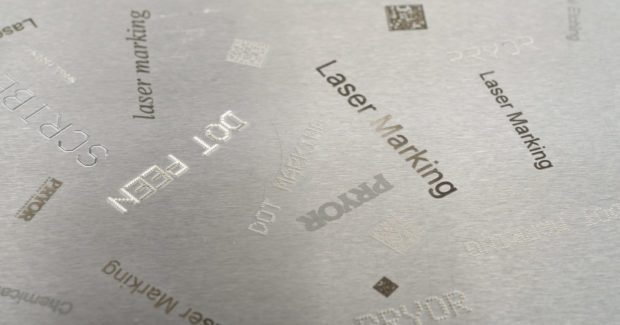Cut Overall Cycle Time With On-The-Fly Laser Marking Machines
Shaving every second possible from each process is a key objective for high-speed, high-volume manufacturers. Laser marking on the fly helps by recording data on a moving target in milliseconds. Pryor Marking Technology’s Alastair Morris explains.
Posted: August 12, 2020
BY ALISTAIR MORRIS
Marking numbers and other information on products is a crucial task for all manufacturers. Indelibly recording serial, part, or batch numbers takes time, however, creating a momentary delay in overall cycle time. This is a particular problem for high-speed, high-volume manufacturers, which will get worse as automation expands and line speeds increase.
Factory automation has exploded over the last few years as Industry 4.0 digitization initiatives minimize production cost and manufacturing time. According to a recent analysis by Market Research Future, investment in fixed factory automation – like the automotive industry’s high-speed, high-volume production lines that sequence operations by set or predetermined equipment configuration – is expected to reach $120 billion by the end of 2022.
Conventional static marking techniques like scribing or dot matrix can’t keep up with the pace, but high-quality laser marking systems are generally fully automated for incorporation into production lines. Even so, they create a tiny delay that quickly adds up to a significant amount of lost time in large-volume or high-speed applications. In a typical application — say, producing stamped semicircular bearing shells from a material strip — each series of marks must be recorded in half a second or less to keep up with the production process. However, often it’s not feasible to stop a production line for even that long.
The only way to completely eliminate delay is to mark on the fly. An on-the-fly laser marking system tracks the component or assembly as it moves along the production line, producing a precise and indelible mark without hindering flow. This has a huge impact on cycle time and represents a major advantage.
I Feel The Need For Speed
On-the-fly laser marking has obvious advantages, but presents a number of technical challenges.
The system must ensure the mark, which can be complex, is placed correctly and to the required quality. There are a number of requirements related to marking components and materials. For example, marks must be permanent and indelible, clearly legible, and may have to appear several times on a single component. There may also be predefined locations. A marking window of around 0.16 inches square (100 mm2) is a common specification.
All these requirements must be considered along with factors such as the volume of data to be recorded during each marking process, line speed, and how much time is available for the marking process. In addition, material qualities, such as hardness, as well as depth must be taken into account.
Some applications require only a serial number, production day number, or batch number. Others must uniquely mark components as part of a sophisticated data capture system for an individual unit as it passes through the production cycle.
To ensure the mark meets all these requirements, it’s vital that line speed is accurately recorded at all times. An encoder wheel that sits on the conveyor or the material typically measures this. This data is fed back to the marking machine to accommodate fluctuations in speed.
In a continuous production process, the operator might be required to record a mark every 3.3 feet (1 meter) or every 5 feet (16 meters) to 33 feet (10 meters). Laser marking systems accommodate any scenario given that line speed is accurately known.
Marking Materials At High Speed
Sensors, typically light detection or through-beam, trigger the marking process when the part or material enters the marking window. All relevant data is captured by a combination of sensors and high-definition cameras as the component moves through the making window, with data being recorded and analyzed by the time each component exits the machine.
High-energy fiber lasers are particularly advantageous for high-volume, high-speed marking applications. The laser beam is transmitted through optical fibers housed in flexible cables, providing the maneuverability necessary to deliver the beam to a moving focusing element. In addition, beam is powerful enough to permanently mark even resistant metals such as hardened steel.
To match the marking process to higher line speeds, you can do one of two things: use a higher-power laser to inscribe marks of sufficient depth and clarity over a shorter period of time or use a larger marking window to provide more time for marking. Either way, it can take as little as half a second to record a complete machine-readable Data Matrix code. This is a standard two-dimensional code consisting of black and white cells or dots arranged in a square or rectangular pattern, with a unique identifier for each component or material section.
Inevitably, each installation is unique to the specific application and must be customized. In some cases, the marking system is designed with the production process from the ground up. For most applications, however, the marking process must be integrated into an existing line where space is limited by equipment that’s already in place. While the core laser technology and accompanying software package are similar, machine hardware varies on a case-by-case basis.
Building A Platform For The Digital Factory
In addition to marking, a verification and quality control system is critical to ensure marks are of suitable quality and correctly located. Verification confirms the mark is machine-readable and meets industry standards related to 2D Data Matrix codes.
Reading a 2D Data Matrix at high speed can be challenging, requiring the use of a high-spec camera and precise illumination. When marking on metal, the surface could have imperfections or scratches and is likely to be reflective. This demands the use of intricate illumination patterns to ensure sufficient contrast. The position and color spectrum of individual lighting elements is critical.
In addition, verification can employ data capture software that allows manufacturers to log component quality and can interface with in-house PLC systems and manufacturing execution system (MES).
This data may be layered, adding new information as a component passes through the production process. The data is read at different stages before additional information is tagged to that component. By recording the time and day the part was processed at each station and each subsequent inspection process, it’s possible to analyze the productivity of specific lines or ensure components that failed verification can be rejected or rechecked at a later stage down the production line.
Capturing data for production purposes is key to increased automation and can yield additional operational benefits, helping to identify and specific problems or production issues.
For high-speed or high-volume manufacturers, on-the-fly laser marking is an opportunity to eliminate time spent on a vital production process. It’s possible to produce a mark identical to one made in the same way on a stationary component without degrading quality.
Producing detailed marks with no distortion, even on components that are moving blindingly fast, laser marking on the fly can be performed at all common production line speeds with no delays in production, reducing cycle time while improving marking quality. With a unique, serialised Data Matrix code applied in as little as half a second, on-the-fly marking lasers are making a move on manufacturing.


















